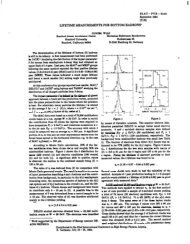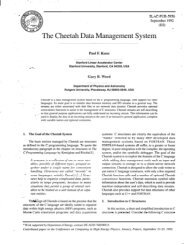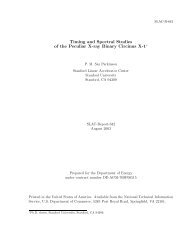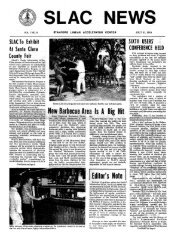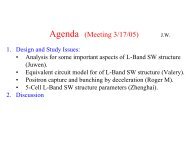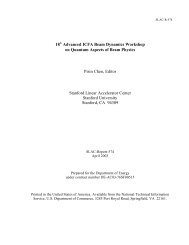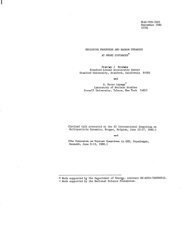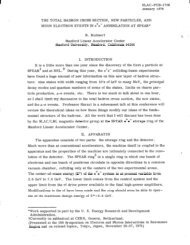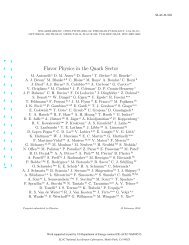B - SLAC
B - SLAC
B - SLAC
You also want an ePaper? Increase the reach of your titles
YUMPU automatically turns print PDFs into web optimized ePapers that Google loves.
New Physics Search in B Decays<br />
(Leptonic and Neutrino Modes)<br />
Missing<br />
& Super B Factory<br />
π −<br />
K + π +<br />
Toru Iijima<br />
π −<br />
π +<br />
e −<br />
Nagoya University<br />
October 17, 2006<br />
Heavy Quark and Leptons 2006 Munich
Talk Outline + Appology<br />
�Introduction<br />
�B�lν (τν, μν, eν, lνγ)<br />
�B�ll (ee, μμ, ττ, llγ)<br />
�B�K (*) νν, νν<br />
�Super KEKB<br />
�Summary<br />
Appology:<br />
Due to limited time, some of<br />
them cannot be mentioned<br />
or have to be put in backup .<br />
2
Introduction<br />
� If New Physics found at LHC at TeV scale, they must<br />
appear in loops as well and change amplitudes.<br />
� It is easier to see the effects when SM amplitudes are<br />
small (or zero).<br />
Rare Decays !!<br />
� B decay has many patterns to test the effects.<br />
b<br />
Penguin Box Annihilation<br />
+<br />
l<br />
+<br />
l<br />
−<br />
l<br />
b<br />
γ , Z<br />
−<br />
ν<br />
W<br />
t<br />
W −<br />
l<br />
s<br />
b<br />
W −<br />
t<br />
W +<br />
s<br />
u<br />
ν<br />
Higgs mediation<br />
l<br />
3
Hunting Rare Decays<br />
In 1993…<br />
CLEO<br />
First evidence of<br />
B�K*γ<br />
PRL 71, 674 (1993)<br />
4
Hunting Rare Decays<br />
� High luminosity<br />
� Good detector (PID, vertex…)<br />
� Analysis techniques<br />
– qq background suppression<br />
– Fully reconstructed tag<br />
Observation of B�K l + l -<br />
CPV in B decay<br />
FB asymmetry in B�K* l + l -<br />
Direct CPV in B 0 �K + π −<br />
Beginning of B->φK 0 saga<br />
Evidence of B�τν<br />
Observation of b�dγ<br />
Success of of B factories brought rare B decays in in<br />
leptonic and neutrino modes on on the stage !<br />
!<br />
5
B�lν<br />
� Proceed via W annihilation in the SM.<br />
� SM Branching fraction<br />
Br(τν)=1.6x10 -4<br />
Br(μν)=7.1x10 -7<br />
Br(eν)=1.7x10 -11<br />
� In two Higgs doublets model, charged Higgs exchange interferes<br />
with the helicity suppressed W-exchange.<br />
Br =Br<br />
Provide f B|V ub|<br />
SM<br />
2 ⎛ m ⎞<br />
B 2<br />
× r, H r H = ⎜1-tanβ 2 ⎟<br />
⎝ mH<br />
⎠<br />
� If μν is also measured, lepton<br />
universality can be tested.<br />
� SUSY correction etc.<br />
2<br />
6
Full Reconstruction Method<br />
� Fully reconstruct one of the B’s to tag<br />
– B production<br />
– B flavor/charge<br />
– B momentum<br />
e−<br />
(8GeV)<br />
Υ(4S)<br />
B<br />
B<br />
e+(3.5GeV)<br />
π<br />
full (0.1~0.3%)<br />
reconstruction<br />
B�Dπ etc.<br />
Single B meson beam in offline !<br />
Decays of interests<br />
B�Xu l ν,<br />
B�K ν ν<br />
B�Dτν, τν<br />
Powerful tools for B decays w/ neutrinos<br />
7
B�τν Analysis<br />
� Extra neutral energy in calorimeter E ECL<br />
– Most powerful variable for separating signal and background<br />
– Total calorimeter energy from the neutral clusters which are not<br />
associated with the tag B<br />
Minimum energy threshold<br />
� Barrel : 50 MeV<br />
� For(Back)ward endcap : 100(150) MeV<br />
Zero or small value of E ECL arising only<br />
from beam background<br />
Higher E ECL due to additional neutral<br />
clusters<br />
MC includes overlay of random trigger<br />
data to reproduce beam backgrounds.<br />
8
The First B�τν Evidence<br />
� The final results are deduced by unbinned likelihood fit<br />
to the obtained E ECL distributions.<br />
B�τν<br />
Signal<br />
Signal +<br />
background<br />
Background<br />
Signal shape : Gauss + exponential<br />
Background shape : second-order polynomial<br />
+ Gauss (peaking component)<br />
Σ : Statistical Significance<br />
+5.3<br />
Observe 17.2 events in the<br />
-4.7<br />
signal region.<br />
Significance decreased to 3.5 σ<br />
after including systematics<br />
9
Results (Br & f B Extraction)<br />
� Measured branching fraction;<br />
Br B 1.79 ×10<br />
( → τν ) = ( )<br />
-0.49 -0.51<br />
� Product of B meson decay constant f B and CKM<br />
matrix element |V ub |<br />
( )<br />
+1.6 +1.3 -4<br />
B ub -1.4 -1.4<br />
� Using |V ub | = (4.39 ± 0.33)×10 -3 from HFAG<br />
15% 16% = 14%(exp.) + 8%(V ub)<br />
f B = 216 ± 22 MeV<br />
+0.56 +0.46 -4<br />
fV =10.1 ×10 GeV<br />
f= GeV<br />
+0.036 +0.034<br />
B 0.229 -0.031 -0.037<br />
[HPQCD, Phys. Rev. Lett. 95, 212001 (2005) ]<br />
10
Correction to the FPCP06 result<br />
� Error in the efficiency calculation.<br />
– Due to a coding error, the efficiency quoted in the 1st Belle<br />
preliminary result was incorrect.<br />
� Treatment of the peaking background component.<br />
– Peaking component is subtracted for the central value.<br />
– Re-evaluate its systematic uncertainty.<br />
� The data plots and event sample are unchanged. However, fB and the<br />
branching fraction must be changed.<br />
New value<br />
FPCP04<br />
result<br />
BF(<br />
BF(<br />
B<br />
B<br />
+<br />
+<br />
+<br />
→τ τ<br />
ν ) =<br />
+<br />
→τ τ<br />
ν ) =<br />
( 1.<br />
79<br />
1.<br />
06<br />
0.46<br />
+ 0.<br />
56+<br />
0.<br />
39<br />
−0.<br />
49−0.<br />
46)<br />
0.51<br />
+ 0.<br />
34+<br />
0.<br />
18<br />
−0.<br />
28−0.<br />
16 ×<br />
× 10<br />
The revised paper is being (has been) resubmitted,<br />
and posted as hep-ex/0604018v2.<br />
10<br />
−4<br />
−4<br />
11
B�τν Search @ Babar<br />
� Babar searches for in a sample of 324x10 6 BB events<br />
� Reconstruct one B in a semileptonic final state B�DlνX<br />
D�K π, K π ππ, K π π, K s ππ (X=γ, π from D*0 is not explicitly<br />
reconstructed)<br />
� Require lepton CM momentum > 0.8 GeV<br />
� Require that -2 < cosq B-D0l < 1<br />
� Parent B energy and momentum are determined from the beam energy<br />
� Tagged B reconstruction efficiency ~0.7%<br />
� Discriminate signal from<br />
background using Eextra �τ lepton is identified in the<br />
4 decay modes<br />
12
B�τν Search @ Babar (cont.)<br />
� Observed excess is not significant yet (1.3σ), and set a<br />
limit on the branching fraction and quote a central value.<br />
Deduced f B |V ub |<br />
Babar preliminary<br />
13
Constraints on Charged Higgs<br />
Br = (1.79 ) ×10<br />
+0.56 +0.46 -4<br />
exp -0.49 -0.51<br />
Br = (1.59 ± 0.40) ×10<br />
SM<br />
f B from HPQCD<br />
|V ub| from HFAG<br />
2 ⎛ m ⎞<br />
B 2<br />
r H = ⎜1- tan β<br />
2 ⎟<br />
⎝ mH<br />
⎠<br />
Brexp<br />
= =1.13±0.53<br />
Br<br />
SM<br />
Much stronger constraint than<br />
those from energy frontier exp’s.<br />
2<br />
-4<br />
These regions are excluded.<br />
14
Future Prospect: B�τν<br />
� Br(B�τν) measurement:<br />
More luminosity help to reduce both stat. and syst. errors.<br />
– Some of the syst. errors limited by statistics of the control sample.<br />
� |V ub| measurement: < 5% in future is an realistic goal.<br />
� f B from theory: ~10% now � 5% ?<br />
My assumption Δf B (LQCD) = 5% 5ab -1<br />
Lum. ΔB(B�τν) exp Δ|V ub |<br />
414 fb -1 36% 7.5%<br />
5 ab -1 10% 5.8%<br />
50 ab -1 3% 4.4%<br />
Br(B�τν)/Δm d to cancel f B ?<br />
G.Isidori&P.Paradisi, hep-ph/0605012<br />
If Δ|V ub | = 0 & Δf B = 0<br />
50ab -1<br />
15
B�μν, eν<br />
� BaBar @ 208.7fb -1<br />
Entries Entries / / / / / / 50 50 50 50 50 50 MeV/c MeV/c MeV/c MeV/c<br />
MeV/c<br />
1600<br />
1400 100<br />
1200<br />
80<br />
1000<br />
w/ fully reconstructed tag;<br />
B�D (*) X.<br />
800 60<br />
600<br />
40<br />
400<br />
200 20<br />
3<br />
× 10<br />
BABAR<br />
preliminary<br />
Monte Carlo<br />
B→<br />
μν<br />
B→<br />
eν<br />
MC Background<br />
0<br />
0<br />
1 1<br />
1.2<br />
1.2<br />
1.4<br />
1.4<br />
1.6<br />
1.6<br />
1.8<br />
1.8<br />
2 2<br />
2.2<br />
2.2<br />
2.4<br />
2.4 2.6<br />
2.6<br />
2.8<br />
2.8<br />
3<br />
Lepton<br />
Lepton<br />
momentum<br />
momentum<br />
(B<br />
(B<br />
frame)<br />
frame) (GeV/c)<br />
(GeV/c)<br />
signal<br />
signal<br />
BABAR<br />
preliminary<br />
monoenergetic e or μ<br />
Nobs = 0 in the signal box.<br />
recoiling against Btag<br />
+<br />
-<br />
B B<br />
0<br />
0<br />
B B<br />
cc<br />
qq,{q=u,d,s}<br />
Onpeak Data<br />
Br(B → e ν ) < 7.9 ×10<br />
Br(B → μν ) < 6.2 ×10<br />
@90%C.L.<br />
-6<br />
-6<br />
� Belle @ 140fb -1<br />
w/ “inclusive ” reconstruction<br />
of the companion B.<br />
-6 -1<br />
Br(B → e ν ) < 5.4 ×10 (60fb )<br />
-6 -1<br />
Br(B → μν ) < 2.6×10 (140fb )<br />
@90%C.L.<br />
16
Future Prospect: B�μν<br />
� B�μν is the next milestone decay mode.<br />
� Measurements will offer a cross check to the results<br />
obtained by B�τ ν.<br />
– fB|Vub| determination.<br />
– Test the lepton universality.<br />
– Inclusive-recon method has<br />
high efficiency but poor S/N.<br />
– Hadronic tag will provide very<br />
clean and ambiguous signals,<br />
but very low efficiency. Luminosity (ab<br />
17<br />
-1 3σ at 1.3ab<br />
)<br />
-1<br />
5σ at 3.7ab-1 Extrapolation from the<br />
present Belle analysis<br />
(inclusive-recon.)<br />
limit ∝ 1/ L<br />
limit ∝ 1/L<br />
See also talk by Robertson<br />
at CERN flavour WS (May 2006)<br />
� Method?<br />
Standard Deviation<br />
K.Ikado at BNM2006
B 0 �l + l -<br />
� Proceeds via box or penguin annihilation<br />
SM Branching fractions<br />
Br(B → e e ) ~ 10<br />
0<br />
d<br />
+ - -15<br />
0<br />
d<br />
+ - -10<br />
Br(B → μμ)<br />
~ 10<br />
0<br />
Br(B →νν<br />
) = zero<br />
d<br />
Flavor violating channel (B 0 � e + μ – , etc.) are forbidden in SM.<br />
� New Physics can enhance the branching<br />
fractions by orders of magnitude.<br />
ex.) loop-induced FCNC Higgs coupling<br />
Note:<br />
Br(B → ⎛ ⎞<br />
s ll)<br />
Vts<br />
= ⎜ ⎟ ; 25<br />
Br(B d → ll)<br />
⎝Vtd ⎠<br />
Br(B →ττ<br />
) ⎛m⎞ τ = ⎜ ⎟ ; 300<br />
Br(B → μμ)<br />
⎜ ⎟<br />
⎝mμ⎠ 2<br />
2<br />
d l<br />
d<br />
b<br />
d<br />
∝<br />
6<br />
tan β<br />
4<br />
mA<br />
A 0 ,H 0 , h 0<br />
Present CDF limit;Br(Bs�μμ)<br />
< 1x10 -7 (95%CL) is equivalent<br />
to Br(Bs�μμ) < 4x10 -9 .<br />
B�ττ requires full-reco. tag.<br />
l<br />
l<br />
l<br />
−<br />
+<br />
l<br />
l<br />
18
B 0 �l + l - (e + e - ,μ + μ - ,e + μ - )<br />
Signal regions Events observed<br />
e + e – μ + μ –<br />
e - μ+<br />
111 fb -1<br />
78 fb -1<br />
780 pb -1<br />
B(B 0 � e + e – ) < 6.1 × 10 -8 (90%CL)<br />
B(B 0 � μ + μ – ) < 8.3 × 10 -8 (90%CL)<br />
B(B 0 � e + μ – ) < 18 × 10 -8 (90%CL)<br />
Phys. Rev. Lett. 94, 221803 (2005)<br />
B(B 0 � e + e – ) < 1.9 × 10 -7 (90%CL)<br />
B(B 0 � μ + μ – ) < 1.6 × 10 -7 (90%CL)<br />
B(B 0 � e + μ – ) < 1.7 × 10 -7 (90%CL)<br />
Phys. Rev. D 68, 111101 (2003)<br />
B(B 0 d �μ+ μ − ) < 2.3×10 -8 (90% CL)<br />
It would be interesting to see results with more data.<br />
What about Υ(5S) data at Super-B ?<br />
19
B 0 �llγ (BaBar@ 292fb -1 )<br />
� 320 M BB events<br />
� 0.3 < m ll < 4.9 (4.7) GeV for eeγ (μμγ)<br />
� Background from J/ψ, ψ (2S) decay (leptons) or π 0 decay (γ)<br />
� Reject qq background event shape in a Fisher discriminant<br />
� Observe 0 (3) events in the signal box in electron (muon) events<br />
E (GeV)<br />
Δ<br />
0.4<br />
0.2<br />
0<br />
-0.2<br />
-0.4<br />
BABAR<br />
0.4<br />
preliminary<br />
e + e-γ μ + μ-γ 5.2 5.22 5.24 5.26 5.28 5.3<br />
2<br />
(GeV/c )<br />
mES<br />
B(B 0 → e + e - γ) < 0.7 × 10 -7 (90%CL)<br />
B(B 0 →μ + μ - γ) < 3.4 × 10 -7 (90%CL)<br />
E (GeV)<br />
Δ<br />
0.2<br />
0<br />
-0.2<br />
-0.4<br />
BABAR<br />
preliminary<br />
5.2 5.22 5.24 5.26 5.28 5.3<br />
2<br />
(GeV/c )<br />
mES<br />
Babar preliminary<br />
20
B�K (*) ν ν (b�s w/ two ν’s)<br />
� B�K (*) νν proceeds via one-loop radiative penguin and box diagrams.<br />
� It is highly sensitive to new physics, and theoretically very clean.<br />
� But, experimentally very challenging.<br />
Signature: B�K (*) + nothing.<br />
� Nothing may be light dark matter<br />
(see papers by Pespelov et al.).<br />
Direct dark matter search cannot<br />
see M
B�K (*) νν<br />
� Babar @82fb -1<br />
hadronic and semileptonic tagging<br />
+ -5<br />
Br(B → K νν) < 5.2×10 (90%C.L.)<br />
� Belle @253fb-1 hadronic tagging<br />
+ -5<br />
Br(B → K νν)
SuperKEKB<br />
♦ Asymmetric-energy e + e − collider to be realized by upgrading the<br />
existing KEKB collider.<br />
♦ Super-high luminosity ≅ 8×10 35 cm −2 s −1 → 10 10 BB per yr.<br />
→ 8×10 9 τ + τ − per yr.<br />
♦ Letter of Intent is available at: http://belle.kek.jp/superb/loi<br />
E CM =M(ϒ(4s))<br />
Higher beam current,<br />
smaller β y * and<br />
crab crossing<br />
→ L = 8×10 35<br />
Belle with improved rate immunity<br />
23
Flavor Physics at SuperKEKB<br />
1. Are there new CP-violating phases ?<br />
2. Are there new right-handed currents ?<br />
3. Are there new flavor-changing interactions with b, c or τ ?<br />
SuperKEKB will answer<br />
these questions by<br />
scrutinizing loop diagrams.<br />
ΔS φK 0 (July 2005)<br />
SM predictions<br />
B<br />
_b<br />
s_<br />
d<br />
s<br />
_s<br />
d<br />
Ks<br />
ΔS φK 0 (SuperKEKB)<br />
24<br />
φ
τ<br />
τ�lγ<br />
χ% 0<br />
τ%<br />
τ�3l, lη<br />
(m )<br />
τ μ<br />
h<br />
2<br />
l%<br />
μ%% ( e)<br />
23(13)<br />
γ<br />
LFV Search at Super-B<br />
μ()<br />
e<br />
μ()<br />
s<br />
μ(<br />
s )<br />
τ�lγ<br />
PDG2006<br />
Belle<br />
Babar<br />
τ�lπ/η (‘)<br />
τ�3l<br />
cf) Hayasaka at BNM2006<br />
τ�l Ks<br />
τ�B γ/π<br />
Search region enters into O(10 -8 �10 -9 )<br />
based on eff.<br />
and N BG of<br />
most sensitive<br />
analysis<br />
Estimated<br />
upper limit<br />
range of Br<br />
25
Major Achievements Expected at SuperKEKB<br />
“Discovery” with<br />
significance > 5σ<br />
Case Case 1: 1: All All Consistent with with Kobayashi-Maskawa Theory<br />
Search for New CP-Violating Phase in b � s with 1 degree precision<br />
CKM Angle Measurements with 1 degree precision<br />
Discovery of B � Dτν<br />
Discovery of B � Kνν<br />
Discovery of New Subatomic Particles<br />
sin 2 θ W with O(10 -4 ) precision<br />
|Vub| with 5% Precision<br />
Discovery of B � μν<br />
Discovery of CP Violation in Charged B Decays<br />
Discovery of Direct CP Violation in B 0 � Kπ Decays (2005)<br />
Discovery of CP Violation in Neutral B Meson System (2001)<br />
Observations with<br />
Υ(5S), Υ(3S) etc.<br />
26
Major Achievements Expected at SuperKEKB<br />
“Discovery” with<br />
significance > 5σ<br />
# SUSY GUT with<br />
gluino mass = 600GeV,<br />
tanβ = 30<br />
Case Case 2: 2: New New Physics with with Extended Flavor Flavor Structure<br />
Search for New CP-Violating Phase in b � s with 1 degree precision<br />
Discovery of Lepton Flavor<br />
Violation in τ � μγ Decays #<br />
Discovery of Lepton Flavor<br />
Violation in τ � μγ Decays #<br />
CKM Angle Measurements with 1 degree precision<br />
Discovery of New Right-Handed<br />
Current in b � s Transitions #<br />
Discovery of New Right-Handed<br />
Current in b � s Transitions #<br />
|Vub| with 5% Precision<br />
Discovery of B � Dτν<br />
Discovery of B � Kνν<br />
Discovery of New Subatomic Particles<br />
sin2θW with O(10-4 Discovery of New CP Violation<br />
) precision<br />
in B0 � φK0 Decays #<br />
Discovery of New CP Violation<br />
in B0 � φK0 Decays #<br />
Discovery of B � μν<br />
Discovery of CP Violation in Charged B Decays<br />
Discovery of Direct CP Violation in B 0 � Kπ Decays (2005)<br />
Discovery of CP Violation in Neutral B Meson System (2001)<br />
Observations with<br />
Υ(5S), Υ(3S) etc.<br />
27
Super-KEKB Status<br />
� Super-high luminosity ≅ 8×10 35 cm -2 s -1<br />
– Natural extension of KEKB<br />
– With technology proven at KEKB<br />
� Many key components are tested at KEKB.<br />
Crab crossing will be tested in winter 2007.<br />
Ante-chamber<br />
Installed at KEKB<br />
Crab cavity<br />
Crab crossing<br />
Super-KEKB is a machine which can be build now.<br />
28
Super-KEKB Status<br />
� Letter of Intent (LoI) in 2004<br />
– 276 authors from 61 institutions<br />
– available at<br />
http://belle.kek.jp/superb/loi<br />
– “Physics at Super B Factory”<br />
hep-ex/0406071<br />
� Updates of physics reach and also<br />
new measurements (Υ(5S) run etc.)<br />
are extensively discussed.<br />
– BNM2006 workshop (Sep.13-14)<br />
http://www-conf.kek.jp/bnm/2006/<br />
– 2nd meeting at Nara (Dec.18-19,<br />
after CKM2006@Nagoya)<br />
A lot of activities for physics and detector studies !<br />
You are welcome to join !<br />
29
Summary<br />
� The first evidence of B�τν has obtained by Belle @414fb-1 .<br />
� Successful operation of B factories have finally brought the B<br />
leptonic decays on the stage.<br />
� O(ab-1 ) data will bring B�μν and Bd�μμ for serious examination.<br />
� These enable us to explore New Physics, esp. in large tanβ region,<br />
together with other measurements; ΔmBS, Bs�μμ, B�Xsγ and also τ<br />
decays (τ�μη, τ�μγ).<br />
� O(10ab-1 � The first evidence of B�τν has obtained by Belle @414fb<br />
) data will bring B�Kνν at horizon.<br />
-1 .<br />
� Successful operation of B factories have finally brought the B<br />
leptonic decays on the stage.<br />
� O(ab-1 ) data will bring B�μν and Bd�μμ for serious examination.<br />
� These enable us to explore New Physics, esp. in large tanβ region,<br />
together with other measurements; ΔmBS, Bs�μμ, B�Xsγ and also τ<br />
decays (τ�μη, τ�μγ).<br />
� O(10ab-1 (see talk by A.Weiler)<br />
) data will bring B�Kνν at horizon.<br />
We need a Super B Factory ! !<br />
� Super-KEKB aims at L=8x1035cm-2s-1 � Super-KEKB aims at L=8x10 , with tech. proven at KEKB.<br />
� A lot of activities for physics and detector studies.<br />
� HEP community in Japan is now discussing “Grand Lepton Collider”<br />
plan to accommodate both Super-KEKB and ILC.<br />
35cm-2s-1 , with tech. proven at KEKB.<br />
� A lot of activities for physics and detector studies.<br />
� HEP community in Japan is now discussing “Grand Lepton Collider”<br />
plan to accommodate both Super-KEKB and ILC. Stay tuned !<br />
30
References<br />
� B�lν<br />
– B�τν: Belle (hep-ex/0604018), BaBar (hep-ex/0608019)<br />
– B�μν, eν: Belle (hep-ex/0408132), BaBar (hep-ex/0607110)<br />
– B�lνγ: Belle (hep-ex/0408132)<br />
� B�ll<br />
– B�e+e-, μ+μ-, e+μ- Belle (PRD68, 111101(R) (2003))<br />
BaBar (PRL94, 221803(2005)), CDF<br />
– B�e+e-γ, μ+μ-γ : BaBar(hep-ex/0607058)<br />
– B�τ+τ-: BaBar(PRL96, 241802 (2006))<br />
� B�Kνν, νν<br />
– B + �K + νν Belle(hep-ex/0507034), BaBar(PRL94, 101801 (2005))<br />
– B 0 �K *0 νν Belle(hep-ex/0608047)<br />
– B 0 �νν BaBar(PRL93, 091802(2004))<br />
Due to limited time, some of them cannot be mentioned<br />
or have to be put in backup<br />
31
Backup<br />
32
New Physics in large tanβ<br />
� Leptonic decays (B�lν, ll) are theoretically clean, free from<br />
hadronic uncertainty.<br />
� In particular, they are good probes in large tanβ region, together<br />
with other measurements; Δm BS, B s�μμ, B�X sγ and also τ decays<br />
(τ�μη, τ�μγ). Ex.) G.Isidori & P.Paradisi, hep-ph/0605012<br />
Charged Higgs<br />
b<br />
u<br />
H +<br />
Neutral Higgs<br />
b<br />
d<br />
A 0 ,H 0 , h 0<br />
ν<br />
τ +<br />
See talk by A.Weiler<br />
l<br />
l<br />
−<br />
+<br />
tanβ<br />
MH(GeV)<br />
33
B�τν Candidate Event<br />
B + �� D 0 π +<br />
B- �� τ - ν<br />
K + π - π + π -<br />
e-νν νν<br />
BELLE<br />
20 cm<br />
Missing<br />
K + π +<br />
π −<br />
e −<br />
π −<br />
π +<br />
34
Mass Reach (GeV)<br />
Cont’d<br />
Charged Higgs Mass Reach<br />
(95.5%CL exclusion @ tanβ=30)<br />
Br(B →τν ) Vub<br />
→<br />
∆m V<br />
d td<br />
Luminsoity(ab -1 )<br />
Only exp. error<br />
(ΔV ub=0%, Δf B=0%)<br />
ΔV ub=2.5%, Δf B=2.5%<br />
ΔV ub=5%, Δf B=5%<br />
Note) Ratio to cancel out f B may help (G.Isidori&P.Paradisi, hep-ph/0605012)<br />
V<br />
V<br />
ub<br />
td<br />
from other measurements<br />
35
B 0 �τ + τ - (BaBar @ 210fb -1 )<br />
� Experimentally very very challenging (2-4 neutrinos<br />
in the final state ! )<br />
� High sensitive to NP Bs�μμ at hadron machines<br />
� Analysis<br />
• Reconstruct one B in a fully<br />
hadronic final state B� D (*) X<br />
=>280k events<br />
• In the event remainder, look for<br />
two τ decays (τ�lνν, πν, ρν)<br />
• Kinematics of charged partilce<br />
momenta and residual energy<br />
are fed into a neutral network<br />
to separate signal and BG<br />
Data Control<br />
sample<br />
Nobs=263±19 Nexpect=281±48<br />
-3<br />
Br(B →ττ<br />
) < 4.1×10 @90%C.L.<br />
Phys. Rev. Lett. 96, 241802 (2006)<br />
36
B 0 � ν ν (invisible) @Babar<br />
�Semileptonic tags :<br />
B0�D ( * )-l + ν (D* - �D0 π- )<br />
�Require nothing in recoil:<br />
- no charged tracks, – 8<br />
- limited # of neutral clusters.<br />
�ML fit to E extra<br />
Ns =17 ± 9<br />
Nb =19<br />
+10<br />
-8<br />
�Upper limit (frequentist)<br />
incl. systematics (additive;7.4events,<br />
multiplicative; 10.9%)<br />
B(B 0 → invisible) < 22 × 10 -5 (90%CL)<br />
νν<br />
ννγ<br />
B pairs used:<br />
(88.5±1.0)×10 6<br />
Phys. Rev. Lett. 93, 091802 (2004)<br />
37
Future Prospect: B�Kνν<br />
� Belle @ 250fb -1 (preliminary)<br />
Fully reconstructed tag (by modifying the PID criteria used in<br />
B�τν analysis).<br />
Belle preliminary<br />
Signif. Lum (ab -1 )<br />
3σ 12<br />
5σ 33<br />
cf.) K.Ikado @ BNM2006<br />
Consistent with BG expected<br />
Need Super-B !<br />
38
Advantages of<br />
SuperKEKB<br />
Clean environment � measurements that no other experiment can perform.<br />
Examples: CPV in B � φK0 , B � η’K0 for new phases, B � Ksπ0γ for righthanded<br />
currents.<br />
“B-meson beam” technique � access to new decay modes.<br />
Example: discover B � Kνν. LHCb (0.002 ab -1 SuperKEKB at 50 ab )<br />
-1<br />
Measure new types of asymmetries.<br />
Example: forward-backward asymmetry<br />
in b � sμμ, see<br />
Rich, broad physics program including B,<br />
τ and charm physics.<br />
Examples: searches for τ � μγ and D-D<br />
mixing with unprecedented sensitivity.<br />
No other experiment can<br />
compete for New Physics reach<br />
in the quark sector.<br />
φ3 (DK<br />
φ3 (Bs → KK)<br />
φ3 (Bs → DsK)<br />
|Vub |<br />
(*) Br(B<br />
sin2φ1 φ2 (ππ isospin)<br />
φ2 (ρπ)<br />
)<br />
0 Br(B<br />
→ Dτν)<br />
+ Br(B<br />
→ Dτν)<br />
+ → K + Br(Bs → μ<br />
νν)<br />
+ μ - C10 w/ AFB (K<br />
)<br />
* l + l - C9 w/ AFB (K<br />
)<br />
* l + l - S(K<br />
Br(B → Xsγ)<br />
ACP (B → Xsγ)<br />
)<br />
*0 ΔS(π<br />
sin2χ(Bs → J/ψφ)<br />
γ)<br />
0 ΔS(K<br />
ΔS(η’Ks)<br />
ΔS(KsKsKs)<br />
Ks)<br />
+ K - ΔS(φKs)<br />
Ks)<br />
S(K<br />
Br(B → Xsγ)<br />
ACP (B → Xsγ)<br />
*0 ΔS(π<br />
sin2χ(Bs → J/ψφ)<br />
γ)<br />
0 ΔS(K<br />
ΔS(η’Ks)<br />
ΔS(KsKsKs)<br />
Ks)<br />
+ K - ΔS(φKs)<br />
Ks)<br />
C 9 w/ A FB (K * l + l - )<br />
φ3 (DK<br />
φ3 (Bs → KK)<br />
φ3 (Bs → DsK)<br />
|Vub |<br />
(*) Br(B<br />
sin2φ1 φ2 (ππ isospin)<br />
φ2 (ρπ)<br />
)<br />
0 Br(B<br />
→ Dτν)<br />
+ Br(B<br />
→ Dτν)<br />
+ → K + Br(Bs → μ<br />
νν)<br />
+ μ - C10 w/ AFB (K<br />
)<br />
* l + l - )<br />
-0.5 -0.3 -0.1 0.1 0.3 0.5-0.5<br />
-0.3 -0.1 0.1 0.3 0.5<br />
39<br />
no info<br />
no info<br />
no info
Role of SuperKEKB<br />
What is the origin of CP violation ?<br />
What is the origin of the matter-dominated Universe ?<br />
What is the flavor structure of new physics (e.g. SUSY breaking) ?<br />
EDM<br />
K physics<br />
LHC ILC<br />
Super B<br />
Neutrino<br />
These grand questions can only be answered by<br />
experiments both at the luminosity and energy frontiers.<br />
SuperKEKB will play an essential role.<br />
LFV<br />
Muon g-2<br />
40



